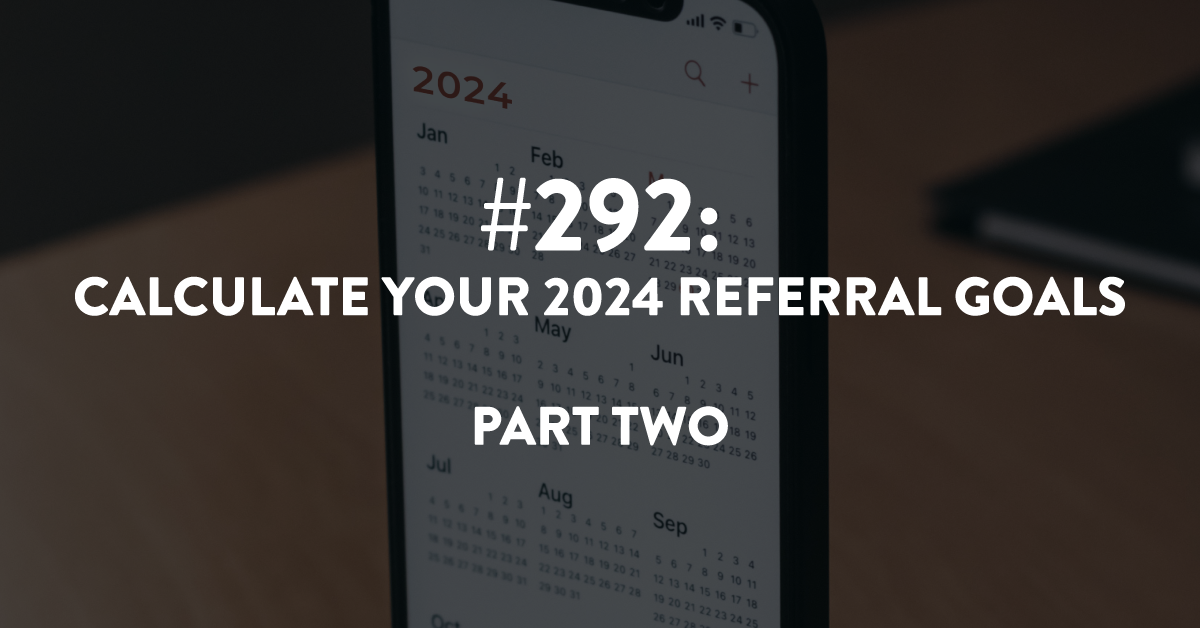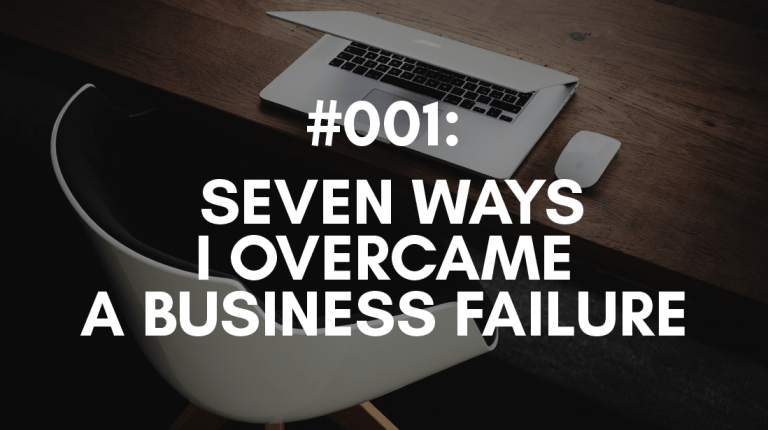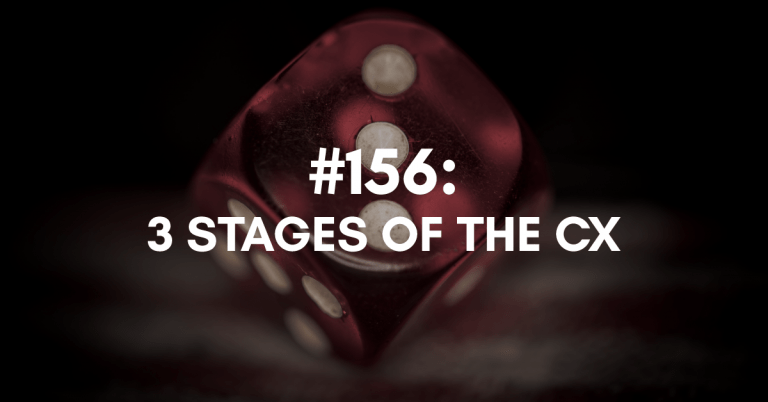Ep #292: Calculate Your 2024 Referral Goals (Part 2)
Setting clear referral goals is essential for building a successful and referable business. Now that we know the three keys to clarity and gathered our past referral data, it’s time to take the next step and start calculating our referral goals for 2024. Let’s recap.
In episode 290, I walked you through the importance of understanding your capacity, both in your personal life and for your business. By analyzing your previous referral results and setting growth expectations, you will know where you stand and where you want to go.
In episode 291, I explained how to gather your past referral data to make informed decisions and set realistic goals for the future.
In this episode, we are ready to start calculating the data you’ve collected, which will create our new referral goals. We also addressed looking for any gaps that may need closing and the importance of taking action and implementing strategies to achieve your referral goals
After you’ve calculated your referral goals, share them with me. Let’s celebrate your progress together! Send me a direct message on LinkedIn or Instagram, or join us on one of our upcoming live training sessions on January 18th or 23rd. During these training sessions, you’ll get even more strategies for doubling, tripling, or even quadrupling your referrals in as little as 90 days.
Links Mentioned During the Episode:
Download the worksheet for data gathering so you can set your 2024 referral goals here.
Want to attend my free, live training on making your Referral Explosion Goals a reality this year? Then submit an application to join the Building a Referable Business™ coaching program. If approved, we’ll send you the training dates (two to choose from). There is no obligation to join BRB after applying or attending the training.
Listen to episode #290 to understand how this referral data fits into the bigger picture of your 2024 Referral Goals.
Next Episode:
Next episode is #293, which is another episode created with you and your needs in mind.
Download The Full Episode Transcript
Read the Transcript Below:
Stacey Brown Randall: It’s time to take the next step in calculating your referral goals. Let’s go.
Hey there and welcome to episode 292 of the Roadmap to Referrals podcast, a show about helping you build a referable business. I’m your host, Stacey Brown Randall. My journey from a business failure to a successful business now 10 years in, I know generating referrals naturally and consistently has made all the difference. Working with clients around the world, we leverage the science of referrals, protect relationships above all else, and help you build a referable business.
So our theme this month here on the podcast, starting with episode 290, is all about setting your referral goals and really taking our time to get clear on what that means for our referrals in 2024.
So we started with episode 290, and I talked about the three keys to clarity when it comes to being able to set your goal. And those three keys to clarity was first understanding your capacity and in particular your capacity as it relates to your life stage and really what you want for your business and of course for your personal life.
And then the second key is your previous referral results, because we really do need to look back to look forward.
And then, of course, the third key to clarity was your growth expectations. So the first thing I asked you guys to do was get really clear on those three things.
Well, but then I followed up in episode 291, where I actually walked you through how to gather the data so that you had your previous referral results. And I provided you with a worksheet to help you in that data gathering.
Hey, if you haven’t actually downloaded the worksheet and you still need it, or you just can’t find it after you downloaded it last week, I want you to be able to go grab it. So please take a minute to go grab that worksheet. It’s on the show notes page for this episode, StaceyBrownRandall.com/292.
Okay, so we have the keys to clarity. Got it. We have gathered our data for our previous referral results. Got it. Now we’re going to talk calculations. And our calculations will then create for us our referral goals.
So using your data, in this episode, we’re going to set three referral goals. Number one, the number of referrals you want in 2024. Number two, how many new people you need referring you, meaning new referral sources. And three, the gaps you need to close so you can make number one and number two a reality.
So from your data worksheet, the one that I walked you through in episode 291, the worksheet that you downloaded at StaceyBrownRandall.com/292. You downloaded it, you listened to last week’s episode 291, and you went in and you actually compiled the data.
You pulled the numbers. You did what you needed to do to make sure you had all your information there, right? I’m saying this because I’m encouraging you to go do it if you haven’t, because it makes everything about this episode better when you actually have this information.
You really can’t set goals without it. I mean, I guess you could, but they’ll be like willy nilly, pie in the sky, kind of just pulled the number out of thin air, unless you’re doing this from your previous data.
So from your data worksheet, you really should have a clear picture of what referrals were like for you in 2023. You should know how many referrals you received. You should know how many became clients, because not every referred prospect becomes a client. You should know how much revenue you made from those who became clients, so from those referred prospects that turned into paying clients.
And you should also know if, you should be able to see and kind of tell, right, hey, is there any referrals that came in in 2023 that still have potential, like they’re still in play. And so how much revenue is potentially there if those still close into a client, even though they’ll be closing into a client this year?
So that’s not everything you kind of uncovered as you went through and did all the data, but those are the big ones, right? Those are the things that you now know and you’re really clear on. Right?
You should also know how many referral sources you had at the end of last year. And that includes how many of those were new from last year, meaning that they referred you for the very first time.
So somebody who referred you last year in 2023, but they refer you every year, obviously they weren’t a new referral source in 2023. They were an existing referral source in 2023. So you have that number, and then you have anybody who referred you for the very first time, meaning they became a new referral source. You also have that number.
Now, here’s the thing. Some of you could be looking at your data being like, these numbers are not impressive. That’s OK. You’re not sharing them. They’re for you. And as long as you’re willing to move the needle forward and do the work to make that number look, those numbers look different next year, that’s the only thing you need right now.
This isn’t like, there’s no judgment. You’re not sharing your numbers with me unless you want to, and that’d be amazing because I’m happy to walk you through some things. But again, it doesn’t come from a place of judgment. It comes from a place of, it is what it is.
The year is done. You cannot fix 2023, like it is back there in the rear view. We can’t go back, but we can make different choices and have different things happen in 2024 if we’re willing to do the work, but we’ve got to know where we’re starting from to know ultimately where we want to go.
So when you’re looking through all of that data that you pulled together, and when you’re looking through, like, hey, who referred you last year for the first time? And you’re looking through who are your referral sources and who’ve been your referral sources, you really pulled together a lot of great information.
The other critical thing you know about your referral sources is that you know their names. At least you better, or it doesn’t count. That’s right. Professor Stacey wants you to know that it does not count if you don’t know their names.
So as you’re pulling together this data, as you’re pulling together this information, you pulled a lot of information about your referrals from 2023. Then you also pulled the how many referral sources, that’s people who refer you, that you had at the end of 2023, including how many of those are new, and you know those referral sources’ names.
In addition to that, you also should have the number of referrals received in 2022 and 2021 as well, because we need all of that to do some really good, good, strong calculations. And when I say like really good, strong calculations, I mean calculations based on results, data, not based on just a number you pulled out of the air, okay?
So the worksheet that you were able to download and that hopefully you did the work in, like you should be looking at a really good screenshot of what referrals looked like for you and your business in 2023 and have some good information, some good baseline information for what referrals look like in 2022 and 2021 because you did the lookbacks, which were all included on that worksheet.
And those lookbacks for 2022 and 2021, they weren’t in depth the way I had you pull information for 2023, but you did pull the referrals that you received, and you did pull the referral sources, the people who referred those to you. So you’ve got a lot of good data, my friend. This is good things, all good things, right? Okay, so now we need to talk about some calculations.
Hey there, pardon the interruption, but before we go too deep into our goals calculation, I want to remind you of something very important happening this month. Two different times this month, I am offering a live training. It’s a live private training where we will calculate your referral goals, and then I’ll walk you through how I help my clients hit their goals. We call it strategy stacking, and it’s also a part of our three-part framework of how I help my clients double, triple, or quadruple their referrals in sometimes as little as 90 days.
So if you want to attend one of these trainings, you have two dates to choose from. It’s the same training on repeat, but they’re both live. But you just have two dates to choose from, and one is coming up super, super fast. So pay attention if you want to get into the one that’s coming up on January 18. I don’t want you to miss it, but you’ve got to submit your application for my coaching program, Building a Referable Business.
When you submit your application for the coaching program, it will also give you the information on selecting the training date you want to attend. So here’s the thing. These trainings are for the people who are at a certain place in their business. That doesn’t mean referral place. It means that you’re in certain industries, you have certain mentalities, you have certain desires and wishes and goals for your referrals. And so you have to complete an application so I can know that you’re a fit for my coaching program because that’s who this training is for.
So of course, there’s no obligation for you to join the coaching program after you attend the training or submit your application but to be able to come to the training you have to submit your application and have it approved because I want to make sure you’re the right fit because I want to make sure the training is worth your time. I certainly don’t want to waste your time.
So to submit your application so that you can attend the training and get all the details, go to StaceyBrownRandall.com/referable. Again, StaceyBrownRandall.com/referable. Now back to the episode.
All right, calculations. Let’s do this. Number one, we’re going to calculate the number of referrals received goal. So this is your goal on the number of referrals you want to receive this year, 2024.
So the first thing you’re going to do is you’re going to take the number of referrals received that you did in your data worksheet from 2021, 2022, and 2023. So you have that information in your worksheet.
And as you look at it, and as you kind of go through it, you’re really looking at, it’s like that, if you’re looking at the worksheet, it’s the very first line in the table, number of referrals received in 2023, and then it’s the bottom two lines in that graph or table that says number of referrals in 2022, number of referrals in 2021.
And of course, on that worksheet, I’ll walk you through how to get to that information so that you have it. But those are the three numbers, and they are, numbers. They are not ranges. This is not a guesstimate. This is in 2021, I got 12 referrals. And in 2022, I got 11 referrals. And in 2023, I got 13 referrals. Whatever those numbers are for you, right? Just throwing out numbers just to throw out numbers, but we’re very, very clear that this is the reality of what we received.
So you take those three numbers, you take the number of referrals from 2021, 2022, and 2023, and you add them together. And then you divide by three, because that’s going to give you the average number of referrals you receive in a year, and that’s averaging it over the last three years.
All right, so when you look at your average number of referrals received, let me just use some really round numbers. It’s probably not real for anybody, but I’m just going to use them. If you received 10 referrals in 2021, 10 referrals in 2022, and 10 referrals in 2023, and you take those three 10s and add them together and get 30 and divide by three, you get 10, which means your average number of referrals in a year is 10.
So from your average, now you get to start thinking about, well, that number is going to go up because I want to set a goal for 2024. And usually when we set goals, it is actually for the number to go up. So what would that look like? If you receive 10 referrals on average in a year, what if your goal was 20?
What if your goal was 20 referrals in 2024, and you were going to do that because you were going to double the number of referrals you received? What if you wanted 30? Now, you can’t look at 10 referrals in a year on average and say, yeah, let’s get to 100 or 1,000. And it actually may even be a stretch for you to get to 50, but we don’t know that until you do the next two calculations that we have to do.
So the first thing you’ve done, if you’ve calculated the number of referrals that you average in a year, and you’re left with a number, right? Not a range, just a number. Maybe it’s 10, maybe it’s 15, maybe it’s 18, maybe it’s 52, maybe it’s 71. Whatever your number is.
And from there, you can start thinking about, wow, what if I doubled that number? What if I tripled that number? What if I quadrupled that number? Those are the measurements I want you thinking in terms of.
Now, have I had clients that I’ve worked with that have averaged 40 referrals in a year and then exploded growth in their very first year? Yes, in terms of 312 referrals.
So I worked with a client. Excellent student. Really did everything I said to do and then took it and ran with it and applied it in so many other ways as well. I mean, just gangbusters. And let’s be honest, the market was ripe for that as well. This was a B2B company that I worked with a couple of years ago but averaged 40 referrals a year.
So I’m looking at that saying, all right, let’s at least try to double it. Let’s get you to 80 referrals in a year. And then we got her 312. And the next year, we got her 302. So pretty amazing, pretty awesome.
I don’t always say that’s the norm. I rarely actually, like if you go to any of my testimonials on any of the pages on my website, you’ll actually probably not see that testimonial because while it happens, and I have had people do that in the past, it’s not necessarily the norm.
Most people, I’m not going to look at them and say, yes, you can go from 40 referrals in a year to 300. Most of the time I’m gonna look at you and say you can go from 40 referrals in a year to like 80, we can double it. Or you can go from 10 or 15 referrals in a year and let’s try to get you to 25, 30, or 45, right? That’s usually the range we’re looking at. But based on your average, you’re gonna set a goal.
Now, here’s what’s gonna impact your goal, and that’s calculation number two. And calculation number two is the number of new referral sources that you are going to need.
Now, did you hear that? When you are generating referrals, they are coming from people, from humans that are referring to you. You need to have enough of them to be able to hit your goals. So the calculation we do on the number of referral sources we need, it’s actually how many new people do we need to add.
So when you looked over your list of who referred you in 2023, 2022, and 2021, because as I mentioned, if you did the worksheet, you have all their names. If you looked over who referred you, how many of those people, of those referral sources, are you keeping and taking with you into 2024? How many of those people do you think actually have the potential and the desire and the opportunity, potential and desire to refer to you again and more in 2024.
So you kind of start with okay. So I looked at all my referral sources over the last three years, and I feel confident that these 15 people are gonna refer me again this year. Because either it was a really strong first referral last year, or they’ve been referring me every year, or they’ve been referring me lots over the last couple of years, whatever it is.
You’re looking at this list of humans, and you’re making the determination of how many of those am I bringing with me into 2024? How many of those do you think can refer you?
So let’s just say you have 15 people on your list. You got 15 referral sources that have referred you in the past. They are existing referral sources, and you feel very confident that more than likely they could refer you in 2024.
But if you’re trying to get from an average of like 10 referrals in a year and now, you’re trying to get to like 20, or 30, or 40 referrals in a year, those 15 people that you have on your list, they may not get you there, which means you’re going to need new people referring you.
So when people always ask me, okay, hey, Stacey, what are the kind of results I can get when I go through your programs, or when I work with you as a coach, or in your coaching program, or I work with you as a VIP? And I always say, I can tell you, but I first got to know your data.
So when I know your data, then I can make some projections for you. Now, I can’t guarantee you’re absolutely going to hit it because, you know, you got work to do and we got to make sure we’re doing the right things at the right time for the right people.
But I know after doing this for over a decade that based on your results, if a few things are true, meaning, how many referral sources do you have already that are going to hopefully provide referrals to you this year? And then how many new people do you need referring you? We can then figure out how we’re going to hit your goal of the number of referrals you want for this year, for this coming year.
And so that’s the question is how many more people do you need referring to you? That’s your second goal. How many new people, how many more new referral sources, new people do I need referring to me?
Some of you may be like, I don’t need anybody else new. I want to get 50 referrals this year, and I’ve got 35 referral sources, and I feel really confident I’ll get referrals from all of them. And from a number of them, I’ll get double referrals, maybe triple referrals. Well, you’re probably actually going to blow over 50 referrals if that’s the case, right? So you don’t need new people. It’s one thing you don’t have to worry about this year is cultivating new referral sources.
But if your goal is like 30 or 50 or 75 referrals this year, and you’re operating off of only 15 people, that you think could refer you, my friend, you have a goal to set for the number of new people you need to cultivate into referring you because you’re going to need more people. It just it is what it is.
All right. So calculation number one is the goal of the number of referrals you want to receive when you look at doubling or tripling, maybe quadrupling the number that is your average from the last couple of years.
The second calculation is how many new referral sources do you need to help you hit that goal you just set with calculation number one.
Okay, and here’s number three. What gaps do you need to close to make sure your 2024 referral goals and the addition of those new referral sources become a reality. What are the gaps? What are the gaps or the processes or the procedures or the strategies that you need to put in place so that you can actually hit what you calculated in number one and number two being your 2024 referral received goal and the number of new people referring you.
So things that I see when people have gaps, the ones that kind of like jump out and bite you, they’re like very obvious, right? When you’ve done the worksheet and you’ve gone through and you’ve answered all the questions that I’ve asked, these are some of the gaps that are typically the ones that bubble up to the top.
Number one, you’re gonna need more referral sources, and so you need a strategy of how to do that, particularly if you don’t wanna be asking people to start referring you, which you shouldn’t, that’s bad. But you’re gonna need a strategy, you’re gonna need to understand and know how to take someone who’s never referred you and get them to start referring you.
So you’re gonna need more referral sources. You may also wanna make sure that those existing referral sources you have on your list actually refer you. So how are you gonna take care of them and plant the right language so that they keep referring you without you having to ask, of course.
You may also have noticed from the worksheet that you completed, some of the other things we haven’t really talked about in this episode, but we talked about in the last episode, do you have quality issues? Do you actually get a lot of referrals, but most of them you end up saying no to or having to find someone else to refer them out to because they’re just not a fit for you? So do you have quality issues?
Here’s the thing. There is nothing worse than getting a whole bunch of referrals only for really none of them to be your ideal client. That’s not fun. So do you have quality issues? Quality meaning, are you not getting your idle client referred to you? You’re getting clients referred to you that don’t fit what you’re trying to accomplish with your clients. They’re not the right fit for clients.
Another thing you may have noticed when you were doing the calculations and pulling the data from the worksheet was if you have a closing rate issue. If you’re not closing 50% or more of your referred prospects, we probably need to pay attention to that.
Now here’s the thing. There are some people that I work with that industry standard for them is like a 10% closing ratio. So we’re super happy if they can get to a 30% or a 35% closing ratio for referred prospects. Because we recognize in their industry, their closing ratio is really, really low.
So I say 50%, that may not actually be your number. And somebody asked me at the retreat that we did for my BRB coaching members, somebody asked me at the retreat, they were like, what’s the number or what’s the percentage that we should be looking for or aiming for, for our closing ratio? And I said, in Staceyland, it’s 50%. I want all my clients to be closing at least 50% of the referrals you receive. Obviously, if you can close more than that, amazing.
Some people, though, I recognize Staceyland doesn’t exist in their industry. And if they have a very low average closing rate, then we’re just trying to like double that or triple what their low average closing rate is.
But again, if you’re getting a bunch of referrals and they are your ideal client and you’re not closing them, that is something to pay attention to. That is a gap to close, my friend. So that’s something you need to make note of, right?
Now that’s just a couple of ideas of things that may have bubbled up for you. Sometimes when people join my program, their question is very simple. The first thing they’re like, we got to solve this tracking issue. Like I actually am doing this work, doing the worksheet work, because the worksheet work you guys did is actually something I do with my clients in my coaching program.
I thought it was really important just to teach you guys, as my listeners of this podcast, what I’m teaching the people that I’m working with. And that is how we set these goals for next year and how we determine what our strategies are for gaps we want to close for the year.
And so, you know, as I’m going through this with my clients, sometimes the question is, I don’t do great with tracking. Like we got to solve the tracking issue. You may have uncovered that as well. You may have said, wow, it was really a pain to pull all this data out because we don’t have it in any one place. It’s not complete and we don’t have it in one place, right?
Or we have to go to different places to actually pull the information or we have some of it, but not all of it. Like sometimes that’s the very first thing we opt to solve with my clients in the coaching program is like, hey, let’s just solve the tracking before we start paying attention to everything else.
So there could have been a number of things that bubbled up for you. I’m just giving you a couple of suggestions of the big ones that I see most bubble up for people when they’re first starting with me.
Because here’s the thing. You can set a goal for the number of referrals you want to receive this year. And you can set a goal for the number of new people you want to start referring you this year. But if you don’t do anything different than you did in the past, if you’re not going to do anything different, then I don’t expect those goals to be a reality for you. Do you? You shouldn’t. Right?
What’s the definition of insanity? Doing the same thing over and over again and expecting different results. So that’s why number three is so valid. It’s so valuable. And it’s so valid to this conversation because you got to know what gaps you got to close so that you can actually be working towards hitting your goals for number one and number two, which were your goal of first, how many referrals do you wanna receive this year? And two, how many new people do you want to start referring you this year?
To hit those two goals, more than likely there’s work to do. And so you need to know what that work is, and then you need to make a decision if you’re gonna actually commit to it.
Okay, here’s what I want you to do for me. I want you to calculate your goals and your numbers, and I want you then to share them with me. You have two ways that you can share these goals with me.
Number one, hop into LinkedIn or Instagram and just direct message me. Just send me a direct message and just say, hey, I listened to episode 291 and 292. I did the worksheet. I calculated my goals. Here’s my goals for how many referrals I want this year, and here’s how many new people I want to start referring to me this year. And then here are some of the gaps I’ve identified I’ve got to close.
Share that with me. I want to celebrate that A, that you did it, and B, be an encouragement that you are capable of making those goals become a reality. So share it with me. Just slide into my DMs. Shoot me a message. You can also send me an email, of course. And let me know that you actually did this work and what your goals are for this year.
So definitely shoot me an email or slide into my DMs on Instagram and LinkedIn. Those are my two preferred social media channels.
The second way to share this with me is actually what I mentioned a little bit earlier in this episode, and that’s joining me for one of my two private live trainings coming up this month, January 18th and January 23rd.
So they’re the same training. I’m just giving you an option of when to choose it. So we have two trainings going on. So of course, you have to apply to attend the training. And the application we use for this training is also the application we use for BRB, Building a Referable Business coaching program, because you’ve got to be a fit for BRB for this training to make any sense for you.
So submit your application. Once you submit your application, if you’re approved, you then get to select which of the two training dates you want to attend. Now, if you’re listening to this and it’s January 18 or after, and you want to attend the training, well, your option is the 23rd. You’re not going to get to pick.
But you can also share these numbers that you’ve set with me in our training. I’ll also walk through this as well during the training. It’ll look a little different when I’m doing it in a training that I’m doing live with a bunch of people in the room, in the Zoom room, but definitely either shoot me a direct message and let me know what your goals are or join me on the training coming up on the 18th or the 23rd of this month and you can share them with me in the chat live right there, share your goals with me as well.
And of course, the resources that I mentioned for this episode, like where is the application to complete so I can come to this training, Stacey? And how do I get the worksheet that I can download so I can do this data gathering and make it easier are all included on the show notes page for this episode, StaceyBrownRandall.com/292.
Okay, and we’re back with another great episode next week, created with you and your needs in mind. Until then, you know what to do, my friend. Take control of your referrals and build a referable business. Bye for now.







